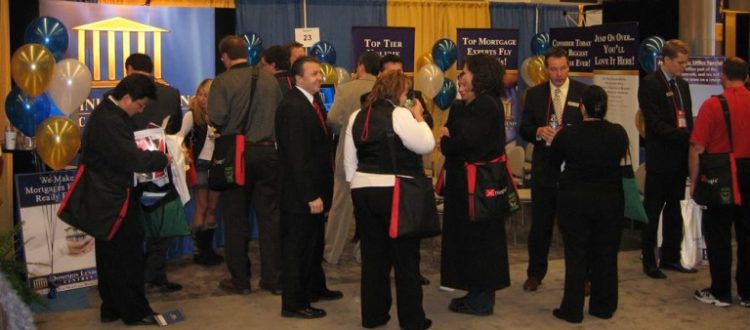These are some of the useful suggestions you can apply when advertising your business in trade show exhibits.
Question: Aside from your recommendation that we use dye sublimation printed fabric banners for our graphics and trade show booth, do you have any other suggestions for our company’s first ever trade show exhibition?
Do I ever! Gorgeous graphics are great, but they will not make a successful trade show. I know that’s probably not the news you wanted to hear, but it’s true. There are some pre-show items you should address before attending any trade show or exhibition.
I know you’re dying to hear what those things might be, so let me say to start with something I’ve said often before, and that is that “the message is the medium.”
Your Message is Your Medium
What exactly to I mean by that? And hopefully you’ve already done what I’m about to suggest, and that is to make sure that you already have a message, or USP (aka your “unique selling proposition”), that you have found to resonate with your market.
If you already know what this is and how important it is, but have not implemented it, then my advice is to take care of this part of your marketing before attending a trade show, as you’ll be spending a lot of money with little chance of success at any convention or trade show.
Determine Your Unique Selling Proposition
If you don’t know how to implement that process of determining your USP, hang on, I’ll explain it in the next few paragraphs. First, though, I need to catch other readers up to speed so they at least understand what a USP is, and why it is of utmost importance.
 Your Unique Selling Proposition is a statement or tagline that succinctly states why your company is different and better than any other company in your category. This is different from branding in that you are not a known commodity other than with your current clients, which, if you were satisfied with the quantity of those, you wouldn’t be considering going to a trade show or convention anyway, so obviously you need to get the word out about who you are and why you’re the best of show, so to speak.
Your Unique Selling Proposition is a statement or tagline that succinctly states why your company is different and better than any other company in your category. This is different from branding in that you are not a known commodity other than with your current clients, which, if you were satisfied with the quantity of those, you wouldn’t be considering going to a trade show or convention anyway, so obviously you need to get the word out about who you are and why you’re the best of show, so to speak.
Hypothetically, let’s say that your company has a new and improved technology for voice over internet protocol (VOIP) telephony. However, it is difficult to explain to prospective clients in one sentence (such as a tagline), and since it does not cost any less (the easiest way to convince anyone to buy anything is to offer it at a cost savings over your competitor, but unfortunately, you don’t have that option and can only offer it at similar pricing even though it’s a much better service and product).
Your prospective clients are generally pretty happy with their VOIP services, and would probably consider switching if you were offering your service at half the cost of your competition, but as stated previously, your technology is better, but your pricing is even. So, how can you, in one sentence or tagline, get your client curious about your service?
As Dan Kennedy and other marketing gurus have stated, you need to find out what your clients’ greatest pain is with their service. For many years it was that there were a lot of dropped calls and line static, so your USP might be something along the lines of “For clear calls that don’t get dropped, switch to ClearVOIP,” or similar.
Split Testing Your Ads
But how do you know this will hit your potential where it hurts? Testing. OK…how is that done? Let’s say you’re already advertising in some national magazines, but you have no idea how your ads are working. You need to change things up a bit.
Keep running the ads…they may be doing some good, but you need to know how they are doing, so you change the tag lines in your ads and run two ads in each magazine with a discount code or similar, and when someone goes to your website, and they want to get a 50% discount for their first month of service, or free set-up, valued at $199 with that ad’s discount code, now you know what ads your clients are responding to.
Running the Two Ads
Let’s say you run one ad with the discount code of “ABC” and the other with the code of “XYZ.” You put the ad in a business journal, and find that the ABC code gets twice as many hits or phone calls than does code XYZ. In the direct advertising business, the winning ad is called the “control.”
You keep the ABC ad, and discard the XYZ ad and replace it with the new ad which is coded “123.” ABC wins again, retaining it’s “control” status and gaining business for your company. However, the next ad with code 1A2 gets twice as many responses as ABC, and it becomes the new “control.”
Applying the Result of the Split Test
After a few rounds of ads, you have determined which taglines and offers are the most responded to, and now you are ready to go to a trade show or convention. You’ve found your message, and with some nice graphic design that incorporates your winning message from the ad coded 1A2, you can go to the show and expect the same type of response to your message at a show as you did in your print ads.
Your attendance at any trade show should be successful because you’ve tested your message, and you know that you get positive response. You’d have never known this had you gone to a convention with a trade show booth, even with gorgeous graphics, but with an untested advertising method. Good luck!
You can visit this page, www.visigraph.com/fabric-vinyl-cloth-banners/dye-sublimation-satin-fabric-cloth-banners/, to find dye sublimation printing on banners with specially designed satin fabrics you can use on your trade show booth.
Popular Posts:




